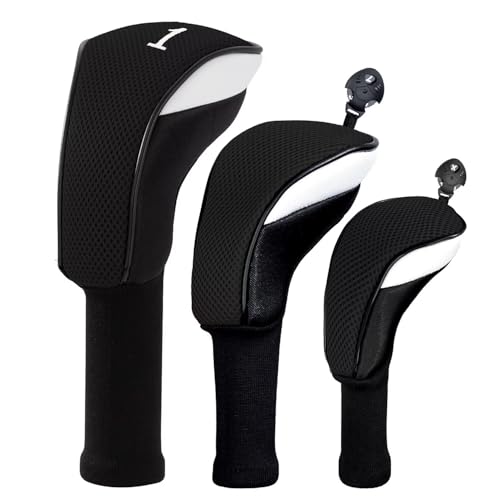Ever wondered why your swing doesn’t feel quite right? It might be down to the length of your golf clubs. Just like a tailored suit, your clubs need to fit your unique swing and body type to play your best game.

Finding the perfect club length can be a game-changer. It’s not just about comfort; it’s about improving your control, accuracy, and overall performance on the course. Let’s dive into how you can tell if your clubs are the right fit for you.
Why club length matters in golf
As someone who’s navigated the fairways for years, you’ll find that one of the subtlest yet most crucial aspects of playing well is the length of your clubs. It’s not just about the aesthetics or the brand—it’s the functionality that matters. When your clubs are of the right length, your swing finds its natural arc, a necessity for consistent ball strikes.
Golf is a game of inches, and when your clubs are too long or too short, they can wreak havoc on your posture. With clubs that don’t fit, you’re forced to adjust your stance, which might lead to an unnatural swing path. The supplementary effort you put in to compensate can lead not only to erratic shots but also to potential injuries over time.
Consider these impacts of improper club length:
- Control: With a club that fits your arm length and height, you have far better control over your clubface at impact, leading to greater accuracy.
- Comfort: The right length allows for a more relaxed stance. You’re not overextending or crouching, reducing strain on your back.
- Swing Speed: A club that’s the correct length enables you to whip it through the air with optimal speed, increasing the potential distance of your shots.
To assess if your clubs are the appropriate length, pay attention to your swing. Are you consistently making contact with the sweet spot? Does your swing feel forced or uncomfortable? Observing your shot patterns during practice can offer insights. Most golfers overlook the telltale signs of club mismatch. If your divot patterns are erratic or you’re often adjusting your grip mid-swing, these are red flags that shouldn’t be ignored.
Regular fittings are imperative, especially as you work on your game and your body changes over time. You wouldn’t drive a car with misaligned wheels, so why settle for clubs that don’t align with your physicality? Achieving this fit might require tweaking the length of your existing clubs or investing in new ones, but rest assured, it’s worth every penny for the precision and comfort it brings to your game.
The impact of incorrect club length on your swing
As someone who’s dedicated countless hours refining every aspect of the game, it’s clear to me that precise club length is non-negotiable. Clubs that don’t match your physique dramatically alter your swing dynamics. An incorrect club length forces you into an uncomfortable posture, either crouched or stretched, which isn’t conducive to a smooth swing.
If your clubs are too long, the tendency is to stand too upright. This position affects your swing plane, causing it to flatten. You’ll struggle to maintain balance, and often the result is a slice—a frustrating fade that starts the ball flight to the left, for right-handers, and veers off sharply to the right. Similarly, if the clubs are too short, they make you bend excessively at the waist and the odds are you’ll pull the ball consistently.
The nature of these issues is that they’re self-reinforcing. Once you’ve adapted to an incorrect length, you start to develop habits that compensate for the misfit. Over time, these become ingrained into your muscle memory, and unlearning them can be as challenging as starting from scratch. Your swing speed suffers too. Expressed in numbers, here’s the potential loss in swing speed you might see:
| Club Length Discrepancy | Estimated Swing Speed Loss |
|---|---|
| 1 inch too long | 2-4 mph |
| 1 inch too short | 2-4 mph |
Remember, a loss in swing speed doesn’t just lessen your power—it disrupts timing and rhythm, both crucial for consistency. To put it in perspective, a reduction of just 4 mph can amount to a distance loss of 8-12 yards off the tee. That’s the difference between a comfortable 7 iron or a demanding 5 iron to the green.
To avoid these complications, you need to look at the direction of your divots. A club that’s the correct length will create a divot that’s both straight and even. On the flip side, an improper length often leads to uneven divots or a divot pattern that clearly shows the heel or toe digging in more drastically. This is a sign that your swing path has been altered to compensate for the club length.
How to measure your club length
In your quest to lower your scores, knowing if you’ve got the right club length is key. Remember, it’s not just about having clubs; it’s about having clubs that are tailored to you. Measuring your club length is straightforward, and you can do it with some simple tools at home.
Start by placing your golf club in the playing position so that the center of the sole is in contact with the ground. You’ll need a 48-inch ruler for an accurate measurement. Position the ruler so that it touches the ground at the same angle that the shaft sits. You want the ruler to extend from the ground up to the top of the grip—the end you hold onto when you’re swinging.
Here’s what you’re looking for:
- For irons and wedges: The measurement is from the ground to the end of the grip.
- For drivers and woods: You measure from the top of the grip to the sole of the club where the bottom of the ball would be when the club is in its natural address position.
Take a note of this length and compare it to standard golf club length charts, which you can easily find online. Here’s a basic guideline:
| Type of Club | Average Length for Men | Average Length for Women |
|---|---|---|
| Driver | 45 inches | 44 inches |
| 5 Iron | 38 inches | 37 inches |
| 9 Iron | 36 inches | 35 inches |
| Putter | 34 inches | 33 inches |
Keep in mind these are averages. Your perfect length may vary based on your height and arm length. If you’re between clubs, leaning toward the shorter club often helps control.
Don’t forget to wear your golf shoes when taking this measurement. The added height from the sole can make a slight, but significant difference in the fitting. If after your measurements your clubs are not aligning with the standard lengths, it might be time to consider a professional fitting. Finding that sweet spot where comfort and control meet will transform your game.
Signs that your club length is incorrect
Have you ever hit a shot that felt off, even though you executed your swing just as you’ve practiced many times? It’s possible that your club length is not quite right for you. As a seasoned low-handicap golfer, I can tell you that improper club length can lead to a multitude of issues on the course. Here’s how to tell if the tools of your trade might be working against you.
Notice your stance and posture. If you’re constantly bending over too much or standing too upright, chances are your club length needs adjustment. When the club is too long, you’ll feel like you’re reaching for the ball; too short, and you’ll be hunched over. This isn’t just uncomfortable—it’s a one-way ticket to inconsistent strikes.

Consistency is the cornerstone of any good golf game. Take note of your shot patterns. Are they erratic? If your contact with the ball is generally good but you’re still suffering from a lack of consistency, the club length might be off. The wrong length can throw off your timing, balance, and the plane of your swing, all of which are critical for hitting those crisp, repetitive shots.
Examine the divots you leave behind. They often tell the tale of what’s happening with your swing. Uneven divots that vary from shot to shot might indicate that your club isn’t the right length. With the correct length, your divots should be fairly consistent—if they’re not, you might be compensating for the length during your swing.
Remember, listening to your body is key. Any discomfort or strain, especially in the back or arms, might suggest that your clubs aren’t suited to your physique. If you’re experiencing any pain or you just feel that something’s off physically, don’t overlook the possibility that your club length is contributing to these issues.
As you keep an eye out for these signs, you’ll start to recognize whether your current set supports your desire to improve. The right club length is instrumental in fostering a dependable swing, one that doesn’t just feel comfortable but also delivers results.
The benefits of having properly fitted clubs
When you’re wielding clubs that are fit to your unique stance and swing, precision and consistency in your game are the first rewards that come knocking. Imagine stepping onto the fairway with a driver cut precisely for your grip and posture—you’ll not only feel more comfortable but you’ll also notice that your shots are more reliable, both in direction and distance.

With clubs that complement your physical architecture, you’ll exert less effort with each swing. This means improved efficiency and less muscle fatigue, which is especially crucial during those long 18-hole rounds. As a result, your performance remains steady from the first tee-off to the last putt. Your endurance may well become the envy of your foursome.
Beyond the physical advantages, there’s a psychological boost too. Confidence on the course can make a world of difference. When you know that your clubs are tailored for you, it’s like having a secret weapon—the confidence gained will show in your shot-making decisions, your swing, and ultimately, your scoring.
Let’s take a peek at some of the immediate benefits:
- Increased accuracy and control
- Enhanced swing speed and distance
- Better ball striking and shot shaping capabilities
- Fewer compensations in your swing, leading to lower risk of injury
- A more consistent golf game, which can lead to lower scores
Remember, while standard clubs can serve you well, it’s the fine-tuning in a club fitting session that gets your gear perfectly synced with your motions. Envision each club as an extension of your body, where the right length sets the stage for a swing that feels both natural and powerful. This synergy between golfer and club is not just a pathway to improvement; it can transform how you experience the game—shifting it from frustrating to fulfilling.
Each time you grip your custom-fit clubs, you’re priming yourself for success. Your clubs are more than just tools; they’re your partners in the dance of golf. As you journey through courses and continue to refine your skills, relish in the knowledge that your equipment is playing its part to perfection.

The process of getting custom-fitted clubs
Imagine stepping onto the course with clubs that feel like an extension of your arms. That’s what it’s like when you invest in a set of custom-fitted golf clubs. The first step is to book a fitting with a certified club fitter. This expert will use the latest technology, along with a good old-fashioned eye for detail, to analyze your swing and physique.
The fitting session typically involves a combination of static and dynamic measurements. Static fittings take into account your height, hand size, and arm length while dynamic fittings evaluate your swing speed, ball flight, and various angles at impact. Don’t be surprised if they ask you to take a few swings with different clubs so they can monitor these factors in real-time.
During a fitting, you’ll hit balls with a club that has sensors attached to it or while standing on a high-tech mat. This is where the magic happens:
- Club Length: Ensures your posture is optimal for every shot
- Lie Angle: Tailored to help prevent hooks or slices
- Shaft Flex: Determined by your swing speed to maximize distance and accuracy
- Grip Size: Matches your hand size to improve control
Bear in mind that a custom fitting isn’t just about numbers. It’s a dialogue between you and the fitter. It’s crucial to communicate what you feel with each swing and what you’re looking to achieve with your game. Be honest about your tendencies and the misses you’re prone to—this information is gold for a club fitter.
Once the data is gathered, your fitter will use it to recommend specific club models and modifications. You’ll have the chance to test these recommendations, often right then and there, to get a sense of how well they work. Your feedback at this stage will fine-tune the selections until you’ve got a set that feels just right.
Remember, the goal of a custom fitting is to provide you with clubs that are tailored to your unique game. Clubs that not only improve your performance but also enhance your enjoyment of the sport. It’s about finding that sweet spot where comfort and technology intersect to help you play your best golf.
Tips for adjusting your club length
When you’ve played golf your entire life, you know the feel of a perfectly sized club in your hands. It’s crucial to tailor your clubs to fit your swing if you want to shoot lower scores. Here’s how you can adjust your club length to better match your game.
First up, stand straight and let your arms hang loosely at your sides. Have a friend measure the distance from your wrist, where the top of the club would normally sit, to the ground. This measurement gives you a baseline to start from. Pro shops and club fitters use more precise methods, but this will get you in the ballpark.
Next, consider the dynamic fitting. This involves hitting some balls at a driving range or fitting center while your swing is analyzed. It’s not just about the static measurement; the way your club moves through the swing is what truly defines the correct length.
If you’re finding your shots consistently veer to the right or left, it might be a sign that your club length is off. Here’s a quick reference:

- Shots to the right could mean your clubs are too long.
- Shots to the left might suggest they’re too short.
Adjusting club length comes down to a few things:
- Trimming the shaft – If you need shorter clubs, you can have the shafts trimmed down. This is pretty straightforward but should be done by a professional to ensure it’s evenly cut without affecting the integrity of the shaft.
- Extending the shaft – Conversely, if you need longer clubs, shaft extenders can be added. It’s a bit tricky since it can alter the feel and weight of the club, so a skilled fitter’s guidance is advised.
Remember, it’s not just about arm length. Your posture and swing mechanics play a big part in deciding the right club length for you. Practice with different lengths and pay attention to the consistency and comfort of each shot. Focus on making fluid, controlled swings to see which length best complements your natural motion.
Lastly, always double-check new adjustments with your club fitter. What feels good on the range needs to be just as effective on the course where it counts. Keep tweaking until you’ve found the sweet spot – when you do, you’ll notice the difference in your game.
Conclusion
You’ve got the basics down and understand that the right club length is key to improving your game. Remember, it’s not just about the measurements—it’s how you feel when you swing. Trust your instincts and don’t be afraid to experiment a bit. After all, golf is as much about comfort as it is about technique. If you’re slicing or hooking more than you’d like, it might be time to revisit your club’s length. And when you make those adjustments, a check-in with a club fitter can be invaluable. They’ll help ensure your tweaks are on point, setting you up for those satisfying shots that keep you coming back for more. Now, go out there and enjoy the game with clubs that feel like they were made just for you.











